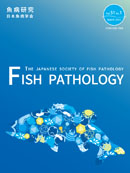
- |<
- <
- 1
- >
- >|
-
Yin-Ze Shi, Issei Nishiki, Soetsu Yanagi, Terutoyo YoshidaArticle type: Research Article
2019Volume 54Issue 3 Pages 51-57
Published: September 15, 2019
Released on J-STAGE: November 09, 2019
JOURNAL FREE ACCESSLactococcus garvieae serotype II, a newly emerging causal pathogen of lactococcal infection, has spread to fish farms since 2012, and its damage to aquaculture has increased. A total of 161 strains were isolated from four fish species, yellowtail Seriola quinqueradiata, amberjack S. dumerili, kingfish S. lalandi, and striped jack Pseudocaranx dentex, in eight prefectures between 2012 and 2017. This is the first epidemiological study on L. garvieae serotype II, by using agglutination titers against antisera for diagnosis, biased sinusoidal field gel electrophoresis (BSFGE) analysis, and antimicrobial susceptibility test. Almost none of these strains were agglutinated with anti-Ia serum (anti-KG- serum), except for two strains agglutinated with both anti-Ia and II sera. BSFGE analysis revealed that genetically homogeneous L. garvieae serotype II has spread to fish farms since the first outbreak in 2012, and the strains resistant to lincomycin were already found in 2015.
View full abstractDownload PDF (734K)
-
Ryo Inoue, Tomohiro TakaseArticle type: Short Communication
2019Volume 54Issue 3 Pages 58-60
Published: September 15, 2019
Released on J-STAGE: November 09, 2019
JOURNAL FREE ACCESSFlavobacterium psychrophilum, the causative agent of bacterial cold-water disease, is classified into two genotypes (A and B) based on peptidyl-prolyl cis-trans isomerase C (PPIC) gene polymorphism. These are routinely detected using restriction fragment length polymorphism of the PCR amplicon (PCR-RFLP). Since this method is difficult and time-consuming, a simple method is required. Here we developed a new method using real-time PCR assay (TaqMan probe assay) to detect single nucleotide polymorphism (SNP) in PPIC region. We designed the probes on a SNP site and performed TaqMan probe genotyping. The results obtained using this method was in line with those of RFLP. This new method could easily and rapidly determine F. psychrophilum genotypes.
View full abstractDownload PDF (978K) -
Hisato Takeuchi, Daiki Nakano, Mayu Iwadare, Ryuji Tomono, Toshihiro I ...Article type: Short Communication
2019Volume 54Issue 3 Pages 61-63
Published: September 15, 2019
Released on J-STAGE: November 09, 2019
JOURNAL FREE ACCESSExperimental infection trials of six riverine fish species with Edwardsiella ictaluri were performed using an immersion method at three water temperatures, 20°C, 25°C, and 30°C. At 20°C, mortalities were recorded only in ayu Plecoglossus altivelis and amur catfish Silurus asotus. Whereas, at 25°C or 30°C, mortality events occurred in other species including Japanese dace Tribilodon hakonensis, gibachi Tachysurus tokiensis, and Japanese eel Anguilla japonica, except for common carp Cyprinus carpio, and high (≥80%) cumulative mortalities were recorded in ayu, amur catfish, and gibachi. These results suggest that many riverine fishes are at risk of E. ictaluri infection during periods of high water temperature.
View full abstractDownload PDF (745K) -
Yasuyuki Miyoshi, Yutaka Fukuda, Kazuo OgawaArticle type: Short Communication
2019Volume 54Issue 3 Pages 64-67
Published: September 15, 2019
Released on J-STAGE: November 09, 2019
JOURNAL FREE ACCESSWe examined how mechanical damages to the skin and the infestation of the monogenean Benedenia seriolae on the skin affected Nocardia seriolae infection in Japanese amberjack Seriola quinqueradiata. After the skin was inflicted damages or after B. seriolae was dewormed with freshwater bathing, amberjacks were challenged with 1.0 × 103 CFU/mL N. seriolae by immersion. Survival rate was significantly lower in the skin-damaged group and the skin fluke-infested group than in their respective control groups. The present study suggests that skin injuries and B. seriolae infection contribute to the N. seriolae infection in Japanese amberjack.
View full abstractDownload PDF (644K)
- |<
- <
- 1
- >
- >|